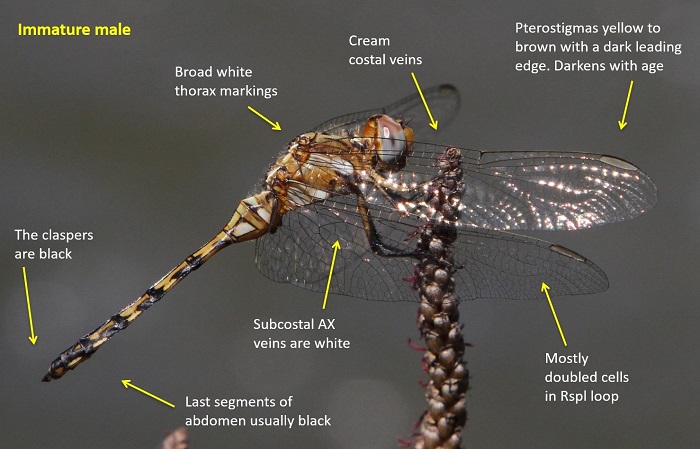The photo above (by Gary Brown) can be viewed in OdonataMAP here.
Find this species in the FBIS database (Freshwater Biodiversity Information System) here.
Family Libellulidae
Orthetrum brachiale – BANDED SKIMMER
Identification
Medium sized
Length up to 57mm; Wingspan attains 82mm.
Most like Orthetrum stemmale (Bold Skimmer). The most reliable way to differentiate between the two is by examining the morphology of the secondary genitalia. This needs to be carefully examined as the genitalia are quite similar. Additionally the cerci/claspers of Orthetrum brachiale are mostly black, while those of Orthetrum stemmale are largely white.
Click here for more details on identification.

Near Kosi Bay, KwaZulu-Natal
Photo by Ryan Tippett

Katanga, Democratic Republic of the Congo
Photo by R. de Cauwer
Habitat
A savanna species that inhabits grass, reed and bush fringes of rivers, streams, pools, dams and marshes. Non-breeding individuals are often found in woodlands away from the water.

Photo by Ryan Tippett
Behaviour
Breeding individuals found on waterside vegetation, but often found away from water in the surrounding woodlands. Perches on exposed twigs among bushes where it hawks insects in rapid flight.
Status and Conservation
Seemingly scarce in South Africa. Listed as of Least Concern in the IUCN Red List of Threatened Species.
Distribution
Widespread throughout much of Sub-Saharan Africa. Reaches its southern limit in the NE parts of South Africa, where it has possibly been overlooked.
Below is a map showing the distribution of records for Banded Skimmer in the OdonataMAP database as at February 2020.

The next map below is an imputed map, produced by an interpolation algorithm, which attempts to generate a full distribution map from the partial information in the map above. This map will be improved by the submission of records to the OdonataMAP section of the Virtual Museum.


Ultimately, we will produce a series of maps for all the odonata species in the region. The current algorithm is a new algorithm. The objective is mainly to produce “smoothed” maps that could go into a field guide for odonata. This basic version of the algorithm (as mapped above) does not make use of “explanatory variables” (e.g. altitude, terrain roughness, presence of freshwater — we will be producing maps that take these variables into account soon). Currently, it only makes use of the OdonataMAP records for the species being mapped, as well as all the other records of all other species. The basic maps are “optimistic” and will generally show ranges to be larger than what they probably are.
These maps use the data in the OdonataMAP section of the Virtual Museum, and also the database assembled by the previous JRS funded project, which was led by Professor Michael Samways and Dr KD Dijkstra.

